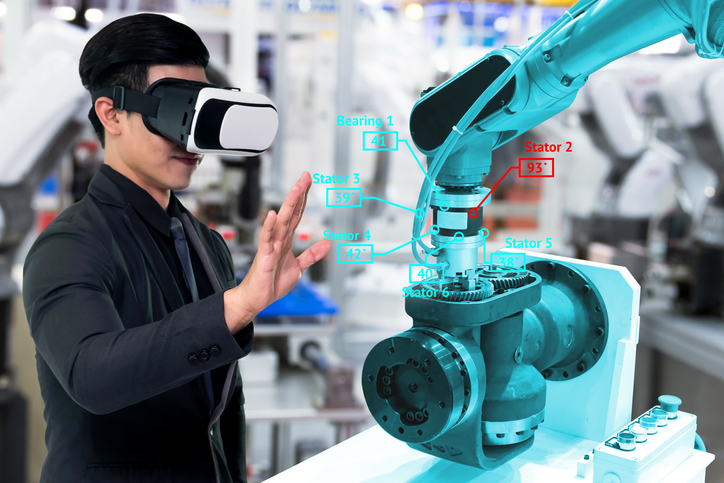Revolutionizing Industrial Robotics Through Virtual Reality

Virtual reality (VR) has been grabbing headlines in recent years, particularly when it comes to consumer electronics. While the futuristic potential of VR often dominates discussions, its practical applications remain largely untapped, especially in the realm of industrial robotics. VR offers transformative possibilities that extend beyond mere entertainment, enabling engineers and designers to push the boundaries of what's possible in automation.
One of the most exciting applications of VR lies in simulating proposed robotic systems. This capability allows robot integrators to showcase proof of concept and proof of design before committing to the construction and installation of a physical system. By creating a digital twin of the proposed solution, VR technology enables teams to identify and rectify potential issues before they become costly problems down the line. Existing robot simulation software provides valuable insights, but VR takes these tools to the next level by offering an immersive, interactive experience.
Enhancing Industrial Robot Design with Immersive Technology
When integrated into robot simulation software, VR transforms the design process by creating a fully immersive environment where engineers can explore every detail of the proposed robotic solution. This level of immersion allows multiple teams of experts to collaborate seamlessly, walking through the virtual system as if it were real. Such collaboration fosters innovation and ensures that the final product meets—or even exceeds—expectations.
In this virtual space, engineers can fine-tune designs with precision, adjusting parameters such as motion paths, payload capacities, and safety protocols. The ability to visualize and interact with a realistic model of the system empowers teams to anticipate challenges and optimize performance. For example, VR simulations can reveal blind spots in the workspace, helping engineers design safer and more efficient systems.
Empowering End Users Through VR
For end users, VR simulations offer unparalleled clarity regarding the proposed robotic system. By stepping into the virtual environment, clients gain a deeper understanding of how the system will integrate into their facilities. This hands-on approach not only demystifies the design process but also allows end users to contribute their expertise. Their intimate knowledge of the application and workspace can inform subtle yet critical adjustments, ensuring the final system aligns perfectly with operational needs.
Moreover, VR simulations help build trust between integrators and end users. When presented with a visually compelling representation of the proposed solution, clients feel more confident in the capabilities of the robotic system. This confidence extends beyond initial satisfaction; it encompasses long-term reliability and productivity. By validating the design through VR, end users can rest assured that the investment will deliver value over time.
Another advantage of VR in industrial robotics is its role in fostering collaboration across disciplines. Engineers, programmers, and end users can all participate in the design process, bringing diverse perspectives to the table. This collective input leads to more robust solutions that account for a wide range of factors, from mechanical constraints to ergonomic considerations.
Ultimately, VR technology elevates the entire field of industrial robotics by enhancing both the quality and accuracy of simulations. Proof of concept and proof of design become far more reliable processes, reducing the risk of costly errors during implementation. For end users, VR provides a comprehensive, interactive preview of what to expect, bridging the gap between abstract concepts and tangible outcomes.
Are you curious about how VR is reshaping industrial robotics? Explore Genesis Systems Group’s 3DG Environment—a groundbreaking VR platform that immerses users in the world of industrial robot design. Discover the future of automation today!
The new 4WD Extended Range Electric System, Magic Carpet Air Suspension, 7.3.4 Panoramic Sound Audio System, Front 4-screen Interactive System with HUD, and NOA Navigation Assisted Driving are the standard features of Li Auto L8.
Li Auto L8 Pro model comes standard with Smart Driver AD Pro and Smart Cockpit SS Pro. AD Pro adopts the world's first Horizon J5 chip and comes standard with high-speed NOA navigation assisted driving, while SS Pro adopts the Qualcomm Snapdragon 8155 chip and a four-screen interactive system in the front row (HUD, Safe Driving Interactive Screen and two 15.7-inch LCD screens in the front row).
Li Auto L8 Max models come standard with Smart Driver AD Max and Smart Cockpit SS Max. AD Max features NVIDIA's dual Orin X chips, LIDAR, and a full suite of redundant systems for self-driving safety. SS Max utilizes Qualcomm's dual Snapdragon 8155 chips and a five-screen, three-dimensional spatial interaction system (HUD, Safe Driver Interactive Screen, and three 15.7-inch LCD screens in the front and rear).
Li Auto L8,Lixiang Li L8,Li Auto L8 Suv Car,Li L8 Max
Shaanxi WLB Auto Sales Co.Ltd. , https://www.wlbauto.com